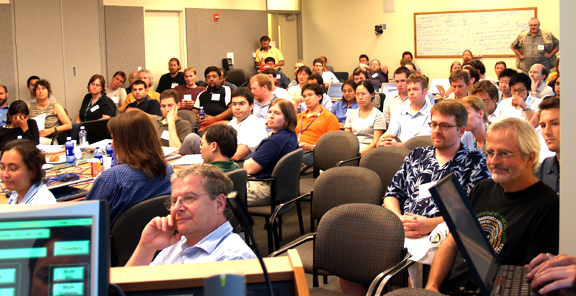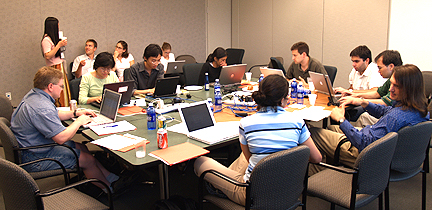| T
H E N I H C A T A L Y
S T |
S
E P T E M B E R – O C T O
B E R 2005 |
|
NHGRI
Hosts 'Geek-Fest' To Start the Ball Rolling
STEP
1: SEQUENCING THE HUMAN
GENOME —

STEP 2: INTERPRETING IT
— ENTER ENCODE
|
by Jim Swyers |
 |
|
Brainstorm:
More than 100 genomic scientists from three continents met in Rockville
for three days in July to plumb the depths of the human genome sequence
|
In
2000, a small group of computer scientists working in relative isolation
at the University of California, Santa Cruz, developed a fairly simple yet powerful
software tool to assemble the almost-complete human genome sequence.
Now, five years after
the completion of an initial draft of the human genome sequence, it is no longer
possible for any single group of individuals—or scientific discipline for
that matter—to make sense of all the data that have been amassed about
the human genome.
Rather, deciphering the
information embedded in the 3-billion–base human genome sequence requires
the combined intellect and talents of multidisciplinary teams of scientists
working collaboratively worldwide.
An initial surprise about
the human genome is that instead of the expected 100,000 or so genes, it appears
to contain only about 20,000 to 25,000 genes. Moreover, most of the estimated
5 percent of the human genome sequence believed to be functionally important
based on evolutionary conservation does not encode protein.
Establishing functions
of these conserved noncoding sequences (as well as other functional regions
that are not evolutionarily conserved) represents a high-priority goal of genomics
programs worldwide.
In an effort to identify
all the functional elements in the human genome, NHGRI recently launched the
ENCODE (Encyclopedia of DNA Elements)
project. ENCODE involves the large-scale generation of experimental and computational
data and the rigorous integration and analyses of the results.
In the initial phase,
an international group of investigators—the ENCODE Consortium—is focused
on analyzing the same set of 44 genomic regions that together account for 1
percent (~30 million bases) of the human genome.
Informing
the ENCODE Project
To establish how best
to analyze the large amount of data already generated by ENCODE, NHGRI’s
extramural and intramural research divisions, along with the NIH
Intramural Sequencing Center (NISC), a major participant in ENCODE, jointly
sponsored an intensive three-day workshop for more than 100 ENCODE consortium
scientists from leading public and private genomic research organizations in
the U.S., Canada, Europe, Japan, and Singapore.
The objective of the workshop
was to begin the detailed analysis required to evaluate and compare the effectiveness
of the many different technologies currently being used to find functional elements
in the human genome.
"All we ask,"
NHGRI Scientific Director and NISC Director Eric
Green told the assembled group at the workshop onset, "is that you
be flexible, spontaneous, and productive."
The proceedings—affectionately
dubbed the "Rockville Geek-fest" by NHGRI Director Francis
Collins in tribute to the fact that most participants were bioinformaticians
and computer scientists—were designed to catalyze the rigorous analysis
of ENCODE data and to help assess progress in interpreting the targeted 1 percent
of the human genome with respect to functional sequences.
"Your job is to compare
all of the different methods used to date in studying this 1 percent of the
human genome, establish what you have and have not learned, and speculate about
which approaches are ready to be used in analyzing the entire human genome,"
Collins said.
Ewan Birney, a senior
scientist at the European Molecular Biology Laboratory–European Bioinformatics
Institute and coordinator of ENCODE data analyses, said that the ultimate goal
of the workshop was to solidify the functioning of five distinctive but collaborative
groups that would eventually lead the ENCODE Consortium in writing "high-impact"
research papers about the areas of study addressed by ENCODE.
 |
|
Gerps
and targs, anyone?: One
of the five analysis groups work in real time during smaller group breakout
sessions
|
The five analysis groups—formed
before the workshop and composed of consortium members—were assigned to
study
 Sequence alignments and conservation
Sequence alignments and conservation
 Genes and transcripts
Genes and transcripts
 Transcriptional regulation
Transcriptional regulation
 Chromatin structure and replication
Chromatin structure and replication
 Sequence variation.
Sequence variation.
The goal is for each to
submit a major paper for publication within the next year.
A
Casual But High-Stakes Affair
Over the course of the
three days, participants alternated between meeting in their separate groups
and massing for presentations and question-and-answer sessions.
Clad in shorts and tee
shirts, and continuously consuming high-carbohydrate snacks and soft drinks,
participants spent much of their group sessions staring intensely at their laptop
screens, occasionally breaking their concentration to ask other group members
about a particular sequence alignment or how a particular piece of data was
derived.
Words like "transfrags,"
"cagetags," "ditags," "gerps," "targs,"
"bincons," and "phastcons" were the major lexicon, and "USB
thumb drives" were the major currency.
Although the typical 16-hour
days at the workshop were grueling for many participants, most said it was well
worth the sacrifice because they were getting the opportunity to work side-by-side
with collaborators they had never before met in person. Many also said that
the stakes were too high not to be involved firsthand in the proceedings.
Garry Cutting, professor
of pediatrics at the Johns Hopkins University School of Medicine in Baltimore,
for instance, was thinking about his cystic fibrosis (CF) patients when he emphasized
the need to understand better the genetic regulation of the CF gene, which resides
in one of the ENCODE target regions.
"Even though the
cystic fibrosis gene was discovered 16 years ago," Cutting said to his
workshop colleagues, "we still do not understand what sequence elements
regulate its expression. If we did, we might be able to use those elements in
designing treatments for patients."
He noted that although
many mutations have been identified, "we also have patients whose mutations
have escaped detection. Their mutations must exist somewhere other than where
we are looking."
In the realm of his particular
primary interest, then, he expects that ongoing gatherings will yield nothing
less than "discovering the location of all the elements that regulate transcription
of the CF gene."
The
Wave of the Future
Workshop organizers were
similarly optimistic at the conclusion of what was considered a quite productive
experience, agreeing that collaborations and large-group interactions are the
wave of the future in genomics research.
"The human genome
is so complex that its full interpretation will require the hard work of large,
diverse teams of energetic investigators. This just can’t be done by isolated
groups any longer," observed Elise
Feingold, NHGRI extramural program director and co-coordinator of ENCODE.
"We see this as only
the beginning of an extraordinarily important set of collaborations—I am
tingling with excitement about all of the positive outcomes of this meeting,"
Birney said. Collins agreed that there would be much to expand upon for years
to come "when all the dust from this workshop settles."
For more information about
the ENCODE project, see the website.

Return
to Table of Contents


